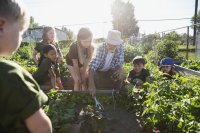Exploring the Benefit Mindset
Helping students see how they can have a positive influence on their community and the world goes beyond teaching and modeling empathy.
As communal creatures, we all crave belonging. Feeling understood and integral among a wide variety of people creates connections that make our lives complete. At our core, each of us is searching for those connections.
Acceptance and affinity are especially important in the classroom, where each student’s social and emotional development directly impacts their academic achievement. Feelings of community and collaboration make learning meaningful for all, and this sense of shared significance is at the heart of a concept called benefit mindset.
Benefit mindset takes the strong seeds of self-belief and self-improvement that growth mindset sows and brings them to fruition in ways that enhance not only one’s own life but the lives of others as well. According to benefit mindset theorist Ash Buchanan, it is “a purpose-driven mindset that is redefining success from being the best in the world, to being the best for the world.” Examining how our attitudes and actions affect others leads us to make conscious and conscientious decisions based on mutual advantage.
Teaching empathy is only a first step. As schools and colleges increasingly require evidence of student service and leadership, we can transform what may begin as extracurricular obligations into enthusiastic, everyday acts of altruism. Without explicit examples and frequent feedback, however, students may be unclear about how to turn their mindsets into action.
Here are four ways teachers can inspire their students to act in ways that break down the divisions between me and we, as students simultaneously become an asset to themselves, to others, and to this planet we share.
Encouraging Inclusion: No Student Eats Alone
Implement a school-wide program to ensure that every student feels welcomed and accepted. Recruit established groups of friends in each grade level to roam the campus looking for classmates who are alone, especially during lunch and recess. These Friendship Ambassadors should invite isolated or withdrawn students to eat or play with them beginning the next day.
After any necessary introductions are made, the Friendship Ambassadors hand out written invitations to lonely students in their grade. These invitations include the ambassadors’ names, where they gather during break times, and some of their common interests. This way, hesitant students have an entire day to prepare for joining a new peer group, rather than immediately being coaxed into an unfamiliar social situation.
If an invited student does not meet up with the group the next day, the ambassadors return with a warm reminder that he or she has an open invitation to hang out with them. When every student finds a sense of place and belonging, the resulting shift in school culture is remarkable.
Providing Peer Support: The Benefit of My Experience
Enlist your students from the previous school year to become academic assistants for your current students. Don’t choose just your hotshots, because every former student—even those who weren’t quite successful last year—has some expertise about how to achieve in your class. Allow every student to share their strengths, and even your once less-than-stellar students will take their mentorship roles seriously.
Right along with the students they are coaching, the peer tutors also benefit from this academic help: Confidence and capabilities increase for both the givers and receivers of this classroom insider advice.
Empowering Change Makers: Students Acting Locally
Ask your students to identify aspects of your classroom and the school as a whole that would benefit from an alteration or addition. Possibilities include shifting to flexible seating, planning and carrying out a library makeover, starting a recycling program, providing peer mediation, planting a garden, providing nutritious meals and snacks, planning school spirit activities, and starting new clubs or a school newspaper.
Allowing students to propose, plan, and enact change teaches them that they can be agents of improvement.
Emphasizing the Positive: Everyday Heroes Report
Create a structured routine where students write and read aloud news reports that exclusively feature noble deeds they have witnessed on campus. Students ask permission to use the names of those whose honorable acts they wish to share and also ask for the humanitarians’ comments. If permission is not given, these stories can be reported without using names.
These short narratives can be read to your class or read over the PA during morning announcements. This is a wonderful way to begin each day and sets a precedent for further acts of kindness. Presenting young people with reliable role models is crucial, and appreciating the good deeds of others is yet another way of extending the impact of a benefit mindset.
Acting with a benefit mindset is not something students put on one Saturday a month for two hours as a grudging act of service—it is a way of being, a way of well-being, that yields powerful results inside and outside of the classroom.
